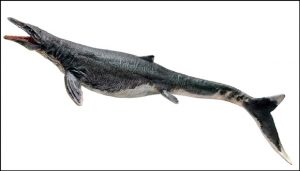Maastricht Mosasaur – Preparation of Rare Fossil Material
Giant Marine Reptile from the Netherlands
Palaeontologists have now recovered parts of the skull, the upper jaw and vertebrae from a thirteen-metre-long mosasaur discovered on the 20th September by cement factory workers. An extinct part of the Order Squamata (lizards and snakes), these large sea lizards were apex predators in the shallow Late Cretaceous seas that covered much of Europe and North America towards the end of the Mesozoic Era. Some of these marine reptiles evolved into huge, fifteen-metre-long giants which fed upon fish, turtles, cephalopods and other marine reptiles such as plesiosaurs. The partial skeleton uncovered in chalk strata at the cement works is the fourth such discovery to be found in the Maastricht area.
A Model of a Mosasaurus
Mosasaurus Fossils
The skeleton is believed to represent a Mosasaurus hoffmani, the first type of mosasaur to be named and scientifically described. At least twenty different mosasaur genera and something like seventy species are recognised today.
The chalk deposits in and around the historic Dutch city of Masstricht have been quarried for centuries. At first the chalk was ignored and flints were mined from the strata, but with the advent of the chemical industry the chalk itself has been excavated for use in lime making and other chemical processes. Whilst working on a new part of the chalk seam, an excavator uncovered part of a fossilised jawbone. Work was stopped and experts from the Masstricht Natural History Museum were called in. Carefully the scientists uncovered parts of the skull, the upper jaws and some back bones, including vertebrae from the animal’s long tail.
Once the specimen has been prepared and cleaned at the museum’s laboratory the palaeontologists hope to be able to put the mosasaur remains on display.
The Masstricht Mosasaur
In the 1770s quarry workers uncovered the disarticulated jawbones of a huge animal in Maastricht. At the time this discovery caused a sensation as the extinction of species and the concept of deep, geological time was not understood. The Dutch naturalist Pieter Camper was given the task of identifying the creature and he concluded that it was a whale.
The French scholar Faujas de Saint-Fond disagreed and stated that the fossil bones represented a reptile and he named the animal as an unknown species of crocodile. In 1800, Pieter Camper’s son (Adriaan), studied the fossils once again and he concluded that this was a sort of giant lizard. Georges Cuvier, the eminent French palaeontologist was contacted, Cuvier was regarded as the world’s leading expert on such finds and it was Cuvier who named the specimen as a Mosasaurus. He agreed with Adriaan Camper, the animal was indeed a form of giant lizard. Cuvier had the opportunity to study the fossils in person as the fossil had been removed to Paris by French troops in 1795. The tableau of fossil material was nicknamed the “Beast of Maastricht” and Mosasaurus means “Lizard of the River Meuse”.
For many years afterwards, a number of prominent 19th century scientists remained convinced that a living specimen of a mosasaur would soon be caught and brought to the attention of the scientific community.
To view models of mosasaurs and other prehistoric marine reptiles: PNSO Age of Dinosaurs.


